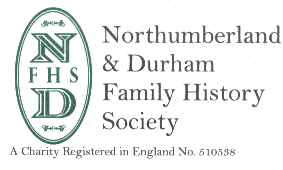
 Reports
Reports

|
South Tyneside Meeting - December 2004"Surnames" by Ken WilkinsonA Report by Margaret Stafford |
Just arrived home, replete from our Christmas buffet which was washed down with an interesting talk on surnames from Ken Wilkinson.
Ken is an historian and admitted to be frankly surprised (and I think a little sceptical) about anyone's ability to trace their surname with any certainty!
A surname is clearly a way of identifying one individual from another but the use of a forename and surname is a relatively modern invention.
Before William the Conqueror people were known by their first name, distinguished from someone of the same name by the use of, for example, "big Harry" or "Harry from the stores". The word nickname derives from eke-literally to stretch out a name. They were used particularly within a community setting such as a monastery. The list of leaders of the monastic community at St Paul's Jarrow for example includes William of Harton, Robert de Durham, John of Beverley, Robert of Elwick and Walter Teasdale.
Using place names is an important feature in the development of surnames, another way of distinguishing individuals was to add a job-related description (still often used in Wales) such as Jones the milk, nurse Jones, Jones the builder.
Family names make up the 4th biggest group for the creation of surnames, as in Williamson and Johnson.
The earliest reference we have to the use of surnames comes in the aftermath of the conquest. Those Normans were excellent administrators and wanted to work out who lived where to ensure all taxes were collected, hence the need to distinguish between all Roberts, Williams or Jacks.
However before getting carried away with the idea of surname linkage there are several cautionary notes. Spelling has had no constancy (and still doesn't!), no wonder with the collector of the information initially being a Norman Frenchman, passing information to be recorded in Latin, from an informant who couldn't read and write anyway so had no idea how to spell his name!
Fowle for example from the Old English for a fowl or bird has at least 12 variants listed in the dictionary of surnames.
It also follows that the surnames derived from place names eg Loads, derived form OLD English lod meaning pathway or course, could occur in many parts of the country and so not all Loads will be related. A man called Roger who moved from Kent to Hampshire might be called Roger Kent to distinguish him from any other Roger in the village but likewise Roger from Kent who moved to Durham could also become Roger Kent. Langley refers to a long meadow and so could occur wherever that topographical feature occurred.
Similarly the name Chapman (selling things from a case) Trotter (a messenger) or Tailor or Cooper could occur wherever someone was carrying out that occupation.
The use of nicknames comes in various forms, Brady derives from the broad-eyed or wide-eyed, Brown from the Old English for brown probably referring to hair colour, Dawes could be a reference to a jackdaw.
Ken had had a look at the surnames within the group (Stafford a place name meaning a ford marked by staves) and advised we were not a representative group as in the population as a whole he would have expected about 50% of surnames to have been derived from place names whereas in our group it was only about one-third.
Many names are given as having first been recorded in 1066 or 1086-those pesky Normans again. If they recorded a piece of land as having been owned by someone since 1066 that meant more taxes, otherwise the date would have been 1086. In fact much name recording is to do with land ownership and taxes.
The oldest land-holding in England is a hide, by and large accepted as a piece of land large enough to allow a family to live by grazing and growing food to eat. Interestingly the Saxons worked in 10s eg 10 pennies to a shilling, it was the Danes who changed that to 12 pennies to a shilling. A hide was generally about one-fifth of a square mile. Land was then grouped into 100 families-or hundreds. William the Conqueror divided the country into counties and called them shires and appointed a servant or reeve to look after the area and collect the taxes-hence a sheriff.
The Domesday book is divided into shires and then hundreds and once a year the sheriff collected the taxes due and sent in his accounts to the king on a roll of parchment-these rolls were often called pipe rolls as they were protected by being encased in clay pipes.
Before the Tudors most information which survives about the population does so within these account rolls. As the population became more mobile than a better way of tracking events was needed and so came the creation of the parish register whereby the vicar or parson or curate had to write in one book the day and year of every wedding, christening or burial and every person's name-and aren't we grateful!!